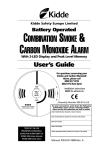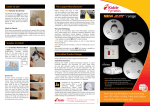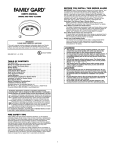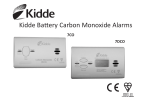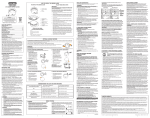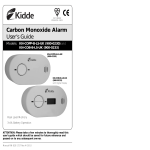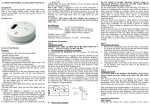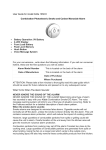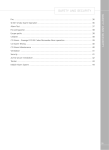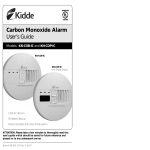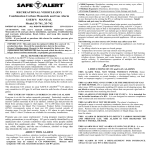Download Kidde-900-0191-User-Manual
Transcript
2520-7201-00.qxd 2006.4.7 3:56 PM Page 1 AC Powered with Battery Backup Carbon Monoxide Alarm User’s Guide with Peak Level Memory, and Battery Backup Model: KN-COPP-3-UK(900 0191) KM 98848 EN50291:2001 Includes a 9 Volt Battery For questions concerning your Alarm, please call Kidde Safety Europe on 01753 685148 Please have information Please havefollowing the ollo f winginformation ready when calling: Alarm Model number (located on front of alarm): Alarm Assembly number (located on back of alarm): Date of Manufacture (located on the back of the alarm): Date of Purchase: Where Purchased: Attention: Please take a few minutes to thoroughly read this manual, which should be saved for future reference and passed on to any subsequent owner. If you have any questions about the operation or installation of your alarm, please call Kidde Safety Europe on 01753 685148 820-1134 REV. A 2520-7201-00 2520-7201-00.qxd 2006.4.7 3:56 PM Page 2 Table of Contents Quick Set Up Guide Introduction • Carbon Monoxide Features • Your CO alarm • What CO alarms can and cannot do Installation • Where to install your alarm • Where not to install your alarm • How to install your alarm Normal Operation • • • • Normal operating characteristics How to test the electronics How to know if your alarm is malfunctioning How to care for your alarm What You Should Know Before the Alarm Sounds • • • • • • The effects of CO exposure Your family can be at risk for CO poisoning Where CO comes from What you can do to protect your family Home safety tips Determine if anyone in the household is at high risk for CO poisoning The Effects of Carbon Monoxide Exposure • Understand the effects of carbon monoxide exposure What to Do When the Unit Alarms • How to respond to the alarm • Who you should call if you suspect you have CO in your home • Sometimes it is difficult to find the source of CO Technical Information • Product Specifications • How the unit determines when to alarm Warranty • Warranty Environmental Protection Waste electrical products should not be disposed of with household waste. Please recycle where facilities exist. Check with Local Authority or retailer for recycling advice. 2520-7201-00.qxd 2006.4.7 3:56 PM Page 1 IMPORTANT THIS CARBON MONOXIDE ALARM IS DESIGNED TO DETECT CARBON MONOXIDE GAS FROM ANY SOURCE OF IMPROPER OR MALFUNCTIONING APPLIANCES. IT WILL NOT SENSE SMOKE, FIRE, OR ANY POISONOUS GAS OTHER THAN CARBON MONOXIDE. FOR THIS REASON YOU MUST INSTALL SMOKE ALARMS TO PROVIDE EARLY WARNING OF FIRE AND TO PROTECT YOU AND YOUR FAMILY FROM FIRE AND ITS RELATED HAZARDS. WARNING! THIS UNIT IS NOT A SMOKE ALARM. IT WILL NOT SENSE SMOKE OR FIRE. IT IS NOT A SUBSTITUTE FOR INSTALLING AND MAINTAINING AN APPROPRIATE NUMBER OF SMOKE ALARMS IN YOUR HOME. FOR EARLY WARNING OF FIRE, YOU MUST INSTALL SMOKE ALARMS EVEN THOUGH CARBON MONOXIDE CAN BE GENERATED BY FIRE. THIS PRODUCT IS INTENDED FOR USE IN ORDINARY INDOOR RESIDENTIAL AREAS. IT IS NOT DESIGNED TO MEASURE COMPLIANCE WITH COMMERCIAL AND INDUSTRIAL STANDARDS. THE INSTALLATION OF THIS DEVICE SHOULD NOT BE USED AS A SUBSTITUTE FOR PROPER INSTALLATION, USE AND MAINTENANCE OF FUEL-BURNING APPLIANCES, INCLUDING APPROPRIATE VENTILATION AND EXHAUST SYSTEMS. INDIVIDUALS WITH MEDICAL PROBLEMS MAY CONSIDER USING WARNING DEVICES WHICH PROVIDE AUDIBLE AND VISUAL SIGNALS FOR CARBON MONOXIDE CONCENTRATIONS UNDER 30 PPM. THIS ALARM WILL NOT WORK WITHOUT POWER. THIS ALARM REQUIRES A CONTINUOUS SUPPLY OF POWER. DURING A POWER OUTAGE, UNIT WILL OPERATE FOR AT LEAST 20 HOURS ON A 9 VOLT BATTERY WITH FULL CAPACITY. ELECTRICAL SHOCK OR MALFUNCTION MAY OCCUR IF TAMPERED WITH, OR NOT INSTALLED IN ACCORDANCE WITH MANUFACTURERS INSTRUCTIONS. 1 2520-7201-00.qxd 2006.4.7 3:56 PM Page 2 Quick Set Up Guide We urge you to read this entire manual in the sequence it is presented. Listed below are five easy steps for setting up your Kidde CO Alarm. Please read this entire guide for complete information. Note: This CO alarm must be installed by a competent person. Step 1 - Determine the best location for your CO alarm(s). Refer to Installation, Where to Install Your Alarm for complete information. Step 2 - Install the 9 volt backup battery. To install the battery, open the back cover and snap the battery connector onto the battery. You will hear the alarm sound briefly to indicate the unit is receiving power. At power up, you will see the the green power LED flash every 15 seconds until the unit is plugged into the mains socket after which the power light will light continuously. It may take up to 30 seconds before remaining on continuously. Approximately 20 seconds the unit receives power it will start sampling for CO. See “Normal Operating Characteristics” for complete information on operating characteristics. Place the battery into the battery compartment and replace the back cover. IMPORTANT! A small screwdriver or similar tool may be required to remove the back cover. The back cover should be levered up from the centre recess at the bottom of the alarm. The cover is designed this way to discourage the removal of batteries, or tampering, by young children. Step 3 - Determine how you want to mount the alarm. Your CO alarm is equipped to be mounted as a corded, a direct plug, or a table top unit. Refer to Installation, How to Install your Alarm for complete instructions about how to configure your alarm for installation. Step 4 - Install the alarm. Plug the alarm into a standard un-switched 230 volt AC electrical outlet in one of the alarm configurations listed in step 3. Wait 2 to 3 minutes after power up and make sure the power light is on. Step 5 - Test the unit’s operation by pressing and releasing the Test/Reset button. The unit will beep once to acknowledge the button was pressed. After a short pause the unit will produce a quick beeping pattern for 8 seconds While testing the alarm, have someone else check that the alarm can be heard easily from the sleeping areas. The unit should be located where it can wake you if it alarms at night. Your alarm is now monitoring for the presence of CO gas. For complete testing information, refer to How to Test Your CO Alarm” section. Caution: Continuous exposure to the loud 85 decibel alarm at close range over an extended period of time may cause hearing loss. We recommend that you cover the front of the unit while testing the alarm with the palm of your hand. 2 2520-7201-00.qxd 2006.4.7 3:56 PM Page 3 Features This Kidde Carbon Monoxide (CO) Alarm is an important part of your family’s home safety plan. As a new owner of a CO alarm, here are some basic facts you should know for your protection and convenience Carbon Monoxide Carbon monoxide is invisible, odourless, tasteless, nonirritating, poisonous gas that is completely undetectable to your senses. It is created when any fuel is burned. When oxygen is limited during combustion, more CO is produced. Serious problems can develop when combustion by-products are not properly vented outside the house. That’s why it’s so important to your safety that you have a CO alarm. Please take the time to read this guide to familiarize yourself with the facts about CO. Know how your new unit works, and what to do if it alarms. Find a handy place to keep the guide so it will be readily available when you have a question. Thank you for making Kidde a part of your complete home safety program. With proper installation and use, your new Kidde CO Alarm should provide you with years of dependable service. 3 2520-7201-00.qxd 2006.4.7 3:56 PM Page 4 Features Your CO Alarm This Kidde alarm is the only CO alarm that gives you the choice of a direct-plug unit, a wall mount unit, or tabletop unit all in one. Front view Alarm Fault Peak Level Button Power Test/Reset Button Rear view Rear view with back door removed Removable Adapter Cord Recess Key Holes Back Door Battery Connector 9 volt Backup Battery Power Cord Adapter Cord Strain Relief 4 2520-7201-00.qxd 2006.4.7 3:56 PM Page 5 Features Kidde CO Alarm Unique Features Test/Reset Button This button has two functions. First, this is the button you press when you test the unit weekly (see “How to test your CO alarm” section). It’s also used when resetting the peak level memory. Peak Level Button If the CO sensor has detected a CO level of 50 PPM or higher, pressing the Peak level button will produce 8 beeps to inform you of a CO incident. The memory must be cleared after each incident, see “The Peak Level Memory Button” section for details Sensors The CO sensor is a highly sensitive, electrochemical sensor that is CO specific to help avoid false alarms. Sounder Alarm This is the loud 85 decibel pulsing alarm that will sound to alert you to a potential problem. Pullout Transformer/Adapter This unique Kidde alarm feature enables the alarm to be used as a direct plug unit, a wall mounted unit or a tabletop unit. 9 Volt Backup Battery This CO alarm is not battery operated. The 9 volt battery is to supply a short-term backup power during a power cut. In the event of a power cut, a fully charged 9 volt battery will continue operating the alarm for at least 20 hours. When installing a fresh battery, use either an Energizer 522, Duracell MX1604 or MN1604, or for extended battery life an Ultralife lithium power cell model U9VL. Any of these batteries can usually be purchased where you bought the alarm or at your local hardware store. 5 2520-7201-00.qxd 2006.4.7 3:56 PM Page 6 Features What Carbon Monoxide Alarms Can and Cannot Do This unit is designed to sense certain levels of CO from malfunctioning furnaces, appliances, gas engines or other sources. This unit will provide early warning of the presence of carbon monoxide, usually before a healthy adult would experience symptoms. This early warning is possible only if your Kidde CO Alarm is located, installed and maintained as described in this user’s guide. This unit is designed to act as a continuous monitor; it is not designed for use as a short-term testing device to perform a quick check for the presence of CO. CO alarms have a limited operational life. You must test your alarm weekly, because it could fail to operate at any time. If it does fail to test properly, or if its self-diagnostic test reveals a malfunction, immediately have the unit replaced. See the back page for warranty information. CO alarms can only sense CO that reaches the unit’s sensor. CO may be present in other areas without reaching the alarm. Doors or other obstructions may affect the rate at which CO reaches the unit. In addition, fresh air from a vent or open window or any other source may prevent CO from reaching the sensor. Please observe cautions in the “Where to install your alarm” section. CO could be present on one level of the home and not reach the alarm installed on a different level. For example, CO in the basement may not reach an alarm on the second level, near the bedrooms. For this reason, we recommend you provide complete coverage by placing a CO alarm on every level of the home. This unit is not a smoke alarm. It will not sense smoke or fire. For early warning of fire you must install smoke alarms, even though a fire can generate carbon monoxide. CO alarms are not a substitute for property, disability, life or other insurance of any kind. Appropriate insurance coverage is your responsibility. Consult your insurance company. Where to Install Your CO Alarm RECOMMENDED LOCATIONS DINING KITCHEN BEDROOM BEDROOM LIVING ROOM BEDROOM WHEN CHOOSING YOUR INSTALLATION LOCATIONS, MAKE SURE YOU CAN HEAR THE ALARM FROM ALL SLEEPING AREAS. 6 2520-7201-00.qxd 2006.4.7 3:56 PM Page 7 Installation Mounting Configuration LOCATION Your Kidde CO Alarm should be mounted in or near bedrooms and living areas or wherever you suspect a CO exposure to be likely. It is recommended that you install a Kidde CO Alarm on each level of a multilevel home. CAUTION: This alarm will only indicate the presence of CO at the sensor. Carbon monoxide may be present in other areas. IMPORTANT: Improper location can affect the sensitive electronic components in this alarm. Please see the next section describing where NOT to install this alarm. Where Not to Install Your CO Alarm To avoid causing damage to the unit, to provide optimum protection, and to prevent unnecessary alarms, follow the directions below where NOT to install this alarm: It is not recommended that you install this CO alarm in garages or kitchens. Installation in these areas could lead to nuisance alarms, may expose the sensor to substances that could damage or contaminate it, or the alarm may not be heard by persons in other areas of the home, especially if they are sleeping. In the garage, vehicle exhaust can contain some CO. These levels are higher when the engine is first started. Within hours of starting a vehicle and backing it out of the garage, the level of remaining CO present can activate the alarm and cause a nuisance alarm. In the kitchen, some gas appliances can emit a short burst of CO upon start-up. This is normal. If your CO alarm is mounted too close to these appliances, it may alarm often and become a nuisance. If you must install a Kidde CO Alarm near a cooking or heating appliance, install AT LEAST 1.8 metres (7 feet) away from the appliance. Do not install the alarm in excessively dusty, dirty or greasy areas such as boiler rooms. Dust, grease, or household chemicals can contaminate or coat the alarm’s sensors, causing the alarm not to operate properly. Do not install within 1.8 meters (7 feet ) of a steam/moisture source, e.g., bathroom or kitchen sink. Do not obstruct the vents on the alarm. Place the alarm where drapes, furniture or other objects do not block the flow of air to the vents. Do not install in dead air spaces, such as peaks of vaulted ceilings, a gabled roof or within 15.2 cm (6”) of ceiling, where CO may not reach the sensor in time to provide early warning. Do not install in turbulent air from ceiling fans. Do not install near doors and windows that open to the outside, near fresh air vents, or anywhere that is drafty. Rapid air circulation from fans or fresh air from outside may cause the sensors to display an inaccurate reading. 7 2520-7201-00.qxd 2006.4.7 3:56 PM Page 8 Installation Do not install this alarm to a switch- or dimmer-controlled outlet if possible Do not install in areas where the temperature is colder than 4.4°C (40°F) or hotter than 37.8°C (100°F). These areas include unconditioned crawl spaces, attics, porches and garages. Extreme temperatures will affect the sensitivity of the alarm. Do not install this unit near deep cell large batteries. Large batteries have emissions that can cause the alarm to perform at less than optimum performance. Avoid the following: • Excessive spillage or reverse venting of fuel burning appliances caused by outdoor ambient conditions, such as: 1) Wind direction and/or velocity, including high gusts of wind. Heavy air in the vent pipes (cold/humid air with extended periods between cycles). 2) Negative pressure differential resulting from the use of exhaust fans. 3) Simultaneous operation of several fuel burning appliances competing for limited internal air. 4) Vent pipe connections vibrating loose from a clothes drier, furnace or water heater. 5) Obstructions in or unconventional vent pipe designs which can amplify the above situations. • Extended operation of unvented fuel burning devices (range, oven, fireplace, etc.). • Temperature inversions that can trap exhaust gasses near the ground. • Car idling in an open or closed attached garage, or near a home. How to Install Your CO Alarm Your Kidde CO Alarm with its removable adapter allows you to install the alarm as a wall mounted unit, a direct plug unit, or as a table top unit. Refer to Where to Install Your CO Alarm for general guidelines. Direct Plug Alarm In its “as shipped” configuration, your Kidde CO Alarm is ready to be plugged directly into a wall-mains socket. To install: 1.) Choose a standard unswitched 230V electrical outlet to plug the alarm into. 2.) Plug the alarm in. Note: Do not cover the alarm with a curtain or other obstruction. 8 2520-7201-00.qxd 2006.4.7 3:56 PM Page 9 Installation Wall Mounted Alarm For a wall-mount, you will need to pull out the removable adapter and power cord. This simple process is described on the following pages. Installation tips for power cord models: The power cord option provides more flexibility in mounting locations and allows the alarm to be easily installed at eye level. Note: If you mount the alarm high on a wall, make sure it is at least 15.2 cm (6") from the ceiling. Any higher than this, it will be in “dead air space” and CO may not reach the sensors. To remove the adapter and install: 1. With the bottom of the unit facing you (adapter at top), use a small screwdriver or similar tool to pry the back cover up to release it. 2. Remove the back cover. 3. Next, place your thumb on the adapter Adapter Release thumb release and pull the adapter thumb release out slightly. Pull the adapter out of the alarm with your other hand. 4. With the adapter removed, pull the power cord out of the cord recess, remove the twist tie, and extend the power cord. 5. With the power cord extended, tuck the last few inches of the power cord into the cord recess (See the illustration on page 4). Gently pull the cord at the bottom of the cord recess until the cord becomes taught and lays flat in cord recess. 6. Using the back cover, mark the location for the two mounting holes on the wall. 7. If you are mounting the alarm in plaster board or WALL drywall, drill a 4.8 mm (3/16") hole into the wall and insert the plastic anchors provided. Install the two screws provided into the wall or wall anchors until the screw head is approximately 3 mm (1/8") from the wall. 1/8" 8. Hook the keyhole in the back cover over the screw head before or after replacing the back cover on the unit. 9. Plug the adapter into an unswitched wall socket. Table Top Alarm You can also use your Kidde CO Alarm as a table top unit. Simply follow the steps for removing adapter, then instead of mounting the alarm to a wall, replace the back cover and stand the unit on a table, bedside stand, or chest of drawers. 9 2520-7201-00.qxd 2006.4.7 3:56 PM Page 10 Normal Operation Normal Operating Characteristics When you first power up the unit, the alarm will sound briefly to let you know the unit is receiving power and that the alarm circuit is functioning. You should see the green power light blink every 15 seconds when the unit is on battery only power and on continuously when powered by AC. Within 20 seconds, your CO alarm will start monitoring for CO and will continue to do so as long as it receives power. When the alarm is unplugged or loses power and you have a good 9 volt battery installed, the alarm will automatically switch to its battery backup mode and you will notice the following: • The green power light will switch from being lit continuously to blink every 15 seconds. • If CO is detected while on battery backup, the alarm will produce a pattern is continuous quick beeps for as long as the CO is present or until the battery is depleted. Note: When AC power is restored, the alarm will automatically switch back to normal operating mode. Low Battery Warning If the 9 volt battery is missing, or if the battery’s power is low, the alarm will beep as well as the red and yellow lights blinking once every 15 seconds. If this happens, you need to replace the battery. When you have a low battery installed, you will notice the following: • Red light blinks in unison with the alarm beeping every 15 seconds. • The yellow light will blink once every 15 seconds. When battery is depleted and the unit is not receiving AC mains power: • Red light blinks in unison with the alarm beeping every 30-45 seconds. • The yellow light will flash approximately every 30-45 seconds. • The green power light will not blink. • Pressing the test button will not elicit any response. The alarm will not detect CO if the battery is depleted. Replace the battery and plug the unit back into the AC outlet. Constant exposures to high or low humidity may reduce battery life. We recommend you replace your 9 volt battery at least every six months. 10 2520-7201-00.qxd 2006.4.7 3:56 PM Page 11 Normal Operation How to Test Your CO Alarm You should test the alarm once a week, following the directions listed below. If at any time you test the alarm and it does not perform as described, have it replaced immediately. Turn to “How to know if your alarm is malfunctioning” section for a description of the characteristics of a malfunctioning alarm and what you should do if a malfunction occurs. Observe the alarm weekly to make sure the green power light is lit continuously indicating normal operation. If the green light is not on or the unit does not respond to pressing the Test button, unplug the alarm for three minutes, and then plug it in again. This will clear the alarm for restart. If the unit still does not respond, your alarm may be malfunctioning. To test the alarm, press the Test/Reset button. If the unit is operating properly, you should notice the following: The unit will beep and the yellow LED will flash acknowledging the button was pressed and the self test has started. After a short pause, you should then hear 8 seconds of quick beeps. It will then return to monitoring for CO. Familiarize yourself and household members with the alarm pattern described above a CO event. While on AC power, in the event of a CO incident, the alarm pattern will continue to repeat as long as CO is present. NOTE: Pressing the Test/Reset button tests the functions of the alarm’s internal components, circuitry and micro-computer. YOU DO NOT NEED TO PRESS THE TEST BUTTON TO TAKE A CO READING. CO readings are taken every 15 seconds automatically. How to Know If Your Alarm is Malfunctioning Your alarm performs an internal self-diagnosis every 15 seconds to make sure that it is functioning properly. The alarm is designed to alert you in the unusual event of a malfunction. If the alarm malfunctions In the rare event that your alarm malfunctions, it will alert you with one of these signal groups (depending upon the type of malfunction that occurs): Malfunction Signal Group 1 - Component Failure – An intermittent “chirping” alarm will sound every 30 seconds. – The yellow LED will light continuously, and – The unit does not respond to pressing the Test button. 11 2520-7201-00.qxd 2006.4.7 3:56 PM Page 12 Normal Operation OR, Malfunction Signal Group 2 - Microprocessor Failure – The alarm will sound continuously, – The yellow LED will light continuously – The alarm cannot be shut off by pushing “Test/Reset” button, and, – The unit is receiving sufficient power from the 230 volt outlet or fresh battery. Unplug the alarm immediately and return for warranty exchange (see “Warranty” on back page). What to do if you’re not sure... PLEASE familiarize yourself with the malfunction alert, Do not confuse these signals with an alarm. After reading the information above, if you are still unsure whether your alarm is operating properly, call the Kidde Freephone Customer Hotline at 0800 917 0722 to do a quick diagnostic check of the alarm over the phone. The customer service representative will be able to assist you and answer your questions. If your alarm sounder is beeping, and you are not sure if it is a CO alarm or a malfunction alert, reset the alarm, open windows for ventilation and evacuate the premises immediately. Then call the Kidde Freephone Customer Hotline at 0800 917 0722 for assistance. Never ignore an alarm. A true alarm is an indication of potentially dangerous levels of CO. How to Care for Your Alarm To keep your alarm in good working order, you must follow these simple steps: • Test the alarm once a week by pressing the Test/Reset button. • Vacuum the alarm cover once a month to remove accumulated dust. Unplug the alarm from the electrical outlet and use the soft brush attachment of your vacuum cleaner. • Instruct children never to touch, unplug, or otherwise interfere with the alarm. • Never use detergents or solvents to clean the alarm. Chemicals can permanently damage or temporarily contaminate the sensor. • Avoid spraying air freshener, hair spray, paint or other aerosols near the alarm. • Do not paint the alarm. Paint will seal the vents and interfere with proper sensor operation. • Do not mount the alarm directly above or near a nappy pail. 12 2520-7201-00.qxd 2006.4.7 3:56 PM Page 13 Normal Operation Note: If you will be staining or stripping wood floors or furniture, painting, wall-papering, or using aerosols or adhesives for a do-it-yourself project or hobby, before you begin: Remove the alarm to a remote location to prevent possible damage to or contamination of the sensor. You may wish to unplug the alarm and store in a plastic bag during the project. The following is a list of substances that at high levels can affect the sensor and cause an alarm. Methane, propane, iso-butane, ethylene, ethanol, alcohol, carbon monoxide, iso-propanol, benzene, toluene, ethyl acetate, hydrogen, hydrogen sulfide, sulfur dioxides. Most aerosol sprays, alcohol based products, fresh paint, thinner, solvent, adhesive, hair spray, aftershave, perfume, auto exhaust (cold start) and some cleaning agents. The Peak Level Memory Button This feature alerts you to possible CO events in your absence. If the CO sensor has detected a CO level of 50 PPM or higher since it was last reset, it will be recorded by the Peak Level Memory function. To access the Peak Level Memory press the Peak button. If a reading of 50 PPM or higher has been recorded, the unit will beep 8 times. If you’ve been away from home this feature allows you to check if there was a CO incident during your absence. Push and hold the Peak button while pressing the Test button to reset the memory. It is also reset when the power is removed. Once the source is located, correcting the problem may be as easy as opening a window, venting an appliance, backing a car out of the garage a safe distance from living quarters, closing the garage door, and letting the car warm up outside. It could be possible that a weather condition caused the reading and the condition may or may not happen again. DO NOT ignore an alarm. Refer to “Part 4- What to Do When the Alarm Sounds for Carbon Monoxide” for more details. To Reset the Peak Level Memory… Step 1. Press and hold the peak level button. Step 2. With the peak level button still pressed, press the test/reset button for two seconds and release. The memory has now been cleared and the alarm will return to monitoring for CO within a few minutes. 13 2520-7201-00.qxd 2006.4.7 3:56 PM Page 14 What You Should Know Before the Alarm Sounds The Effects of CO Exposure When you breathe carbon monoxide, it enters your bloodstream through your lungs and attaches to red blood cells. These red blood cells, called haemoglobin, carry oxygen throughout your body. CO molecules attach to the red blood cells 200 times faster than oxygen, preventing the flow of oxygen to your heart, brain and vital organs. As CO accumulates in your bloodstream, your body becomes starved for oxygen. The amount of CO in a person’s body can be measured by a simple blood test, called a “carboxyhaemoglobin level” test . The early symptoms of CO poisoning are often mistaken for the flu – headache, dizziness, weakness, nausea, vomiting, sleepiness, and confusion. Breathing very high concentrations of CO can be lethal in minutes. Your Family at Risk for CO Poisoning Carbon monoxide is the number one cause of poisoning deaths. While anyone is susceptible, experts agree that unborn babies, small children, senior citizens and people with heart or respiratory problems are especially vulnerable to CO and are at the greatest risk for death or serious injury. Where CO Comes From Inside your home, fuel burning appliances used for heating and cooking are the most likely sources of CO. Vehicles running in attached garages can also produce dangerous levels of carbon monoxide. A by-product of combustion, CO can be a potential problem from a number of common sources such as – a running automobile, a furnace or water heater leak or misuse of a fireplace, wood stove, charcoal grill, a gas range and space heater leak or misuse, and running portable generators where exhaust can enter the home. When appliances are in good working condition and with proper ventilation, lethal CO gas is vented outdoors where it quickly disperses. Even the slightest malfunction or misuse of any of the above sources can lead to a build-up of CO in your home that can become deadly before you even know it’s there. You don’t have to have ancient appliances to have a CO problem. 14 2520-7201-00.qxd 2006.4.7 3:56 PM Page 15 What You Should Know Before the Alarm Sounds Today’s more energy-efficient, airtight home designs can trap CO polluted air inside where it can quickly build to lethal levels. What You Can do to Protect Your Family To be safe, know the possible sources of CO in your home. Keep fuelburning appliances, their chimneys, and vents in good working condition. Learn the early symptoms of CO exposure. If you suspect CO poisoning, move outside to fresh air and get emergency help. A blood test can confirm that CO has caused the symptoms of CO poisoning. Your first line of defence is an annual inspection and regular maintenance of your appliances. Contact a qualified Corgi installer or Transco (British Gas) for assistance. Remember, problems can begin after an inspection has been completed. CO can come from sources such as a crack in a furnace heat exchanger, or a leak in a water heater vent or a bird’s nest blocking a flue. Other sources of CO are nearly impossible to detect; even a change in the air pressure outside can turn a normally safe situation deadly. That’s why you need the 24-hour protection provided by a CO alarm. Home Safety Tips What You Can Do... • Buy only appliances approved by a nationally recognized testing laboratory. • Choose fuel-burning appliances that can be vented to the outdoors. • Make sure appliances are installed according to manufacturer’s instructions and local building codes. Most appliances should be installed by professionals and should be inspected by the proper authority after installation. • Have the heating system, vents, chimney and flue inspected and cleaned by a qualified technician every year. • Follow manufacturer’s directions for safe operation of all fuel-burning appliances. • Examine vents and chimneys regularly for improper connections, visible rust or stains. • Open a window when a fireplace or wood-burning stove is in use, and provide adequate outdoor air for furnace and water heater. • Notice problems that could indicate improper appliance operation: – Decreasing hot water supply – Furnace unable to heat house or runs constantly – Sooting, especially on appliances 15 2520-7201-00.qxd 2006.4.7 3:56 PM Page 16 What You Should Know Before the Alarm Sounds – Unfamiliar or burning odour – Yellow or orange flame • Be aware of the symptoms of CO poisoning: – headaches, dizziness, weakness, sleepiness, nausea, vomiting, confusion and disorientation. • Recognize that CO poisoning may be the cause when family 16 2520-7201-00.qxd 2006.4.7 3:56 PM Page 17 What You Should Know Before the Alarm Sounds members suffer from flu-like symptoms that don’t disappear but improve when they leave home for extended periods of time. Be Aware of the Warning Signs of Carbon Monoxide: Indicators of Possible CO Leaks • Streaks of carbon or soot around the service door of your fuelburning appliances. • A yellow or orange flame may indicate a problem with natural gas appliances. • Excessive rusting on flue pipes or appliance jackets. • Loose or missing furnace panel. • Moisture collecting on the windows and walls of furnace rooms. • Loose or disconnected vent/chimney, fireplace or appliance. • Small amounts of water leaking from the base of the chimney, vent or flue pipe. • Rust on the portion of the vent pipe visible from outside your home. • The absence of a draft in your chimney (indicating blockage). • Fallen soot from the fireplace chimney. • Loose, damaged or discoloured bricks on your chimney. Hidden Causes of CO Emission • Internal appliance damage or malfunctioning components • Improper burner adjustment • Hidden blockage or damage in chimneys Determine if anyone in the household is at high-risk for CO poisoning: Many cases of reported CO poisoning indicate that while victims are aware they are not well, they become so disoriented they are unable to save themselves by either exiting the building or calling for assistance. You should take extra precautions to protect high-risk persons from CO exposure because they may experience ill effects from CO at levels that would not ordinarily affect a healthy adult. Be sure to check infants or small children in the home for signs of possible CO poisoning because they might have trouble explaining their symptoms. Infants and children are more susceptible to CO poisoning than a healthy adult. 17 2520-7201-00.qxd 2006.4.7 3:56 PM Page 18 What You Should Know Before the Alarm Sounds Pregnant women should be aware that their unborn fetus could be harmed by exposure to CO, even when the mother suffers no ill effect. Any pregnant woman who suspects she may have been exposed to CO should immediately contact her physician. What You Should Not Do... • Never burn charcoal inside a home, garage, cabin, mobile home or caravan. • Never install, service, or convert fuel-burning appliances from one type to another without proper knowledge, skills and tools. • Never use a gas range, oven, or clothes dryer for heating. • Never operate unvented gas-burning appliances, such as kerosene or natural gas space heaters, in a closed room. • Never operate gasoline-powered engines (like vehicles, motorcycles, lawn mowers, yard equipment, or power tools) in confined areas such as garages or basements, even if an outside door or a window is open. • Never ignore a safety device when it shuts off an appliance. • Never ignore a CO alarm. 18 2520-7201-00.qxd 2006.4.7 3:56 PM Page 19 The Effects of Carbon Monoxide Exposure Anyone in the household who is elderly, has anemia, heart disease, respiratory problems, emphysema, or chronic bronchitis, is at a higher risk of CO poisoning and health problems from exposure to CO. If anyone in the household is at high risk for CO poisoning, we urge you to take extra precaution to prevent possible poisoning. You should consider a more sensitive alarm for your home safety. If the unit alarms or if CO readings are shown on the digital display, remove the at-risk person from the premises. Ventilate the area. The high-risk person(s) should not re-enter the residence until the source of the CO problem has been identified and corrected. The Effects of Carbon Monoxide Exposure: PERCENT OF CO PARTS PER MILLION 0.01 100 Slight headache within 2~3 hours 0.02 200 Dizziness/mild headache within 2~3 hours 0.04 400 Nausea/frontal headache within 1~2 hrs. RISK TO LIFE OVER 3 HOURS 0.08 800 Severe headache/convulsions within 45 minutes - death possible within 2~3 hours. 0.16 1600 Headache/nausea within 20 minutes. Death possible within 1~2 hours. 0.32 3200 Headache etc. within 5-10 minutes. Death possible within 15 minutes. 0.64 6400 Sever symptoms within 2 minutes. Death within 15 minutes. 1.28 12800 Death within 1~3 minutes. EFFECTS ON ADULTS Source: Corgi Gas installers technical article - October 2005 19 2520-7201-00.qxd 2006.4.7 3:56 PM Page 20 W What To Do When The Alarm Sounds h What to Do When the Alarm Sounds for Carbon Monoxide a Determine if anyone in the household is experiencing sympof CO poisoning. Many cases of reported CO poisoning t toms indicate that while victims are aware they are not well, they become so disoriented they are unable to save themselves by either exiting the building or calling for assistance. Also young children and household pets may be the first affected. The following symptoms are related to CARBON MONOXIDE POISONING and should be discussed with ALL members of the household. t o d o WARNING: Actuation of this CO W h e n t h e A l a r m S o u n d s Alarm indicates the presence of Carbon Monoxide (CO) which can kill you. When the CO alarm senses a dangerous level of CO, the unit will emit a loud alarm pattern of short beeps. This pattern is repeated until the CO concentration has dropped to normal level. Know how to respond to a CO emergency. Periodically review this user’s guide and discuss it with all members of your family. If the Alarm Sounds: 1) Operate test/reset button; 2) Call Transco (British Gas); 3) Immediately move to fresh air. Do a head count to check that all persons are accounted for. Do not re-enter the premises until British Gas responders have arrived, the premises have been aired out, and your CO alarm remains in its normal condition. 4) After following steps 1-3, if your alarm reactivates within a 24 hour period, repeat steps 1-3 and call a qualified Corgi installer to examine and/or turn off your gas/oil fired appliances such as space heater, boiler, water heater, cooker oven, clothes dryer or other source of combustion, such as paraffin burning stove or heater or gas log fireplace. If your car is idling in an attached garage, turn off the engine. 5) To investigate for sources of CO from fuel burning equipment and appliances, and inspect for proper operation of this equipment. If problems are identified during this inspection have the equipment serviced immediately. 20 2520-7201-00.qxd 2006.4.7 3:56 PM Page 21 What To Do When The Alarm Sounds W h a t Note any combustion equipment not inspected by the technician and consult the manufacturer’s instructions, or contact the manufacturer directly, for more information about CO safety and this equipment. Make sure that motor vehicles are not, and have not been, operating in an attached garage or adjacent to the residence. Treatment for CO Poisoning Any person who is suspected to have CO poisoning should leave the potentially dangerous environment, get fresh air immediately and seek care from a physician. CO poisoning can be determined by a simple blood test, called a “carboxyhaemoglobin” test. This test measures the amount of CO in the bloodstream. For this test to be accurate, it must be done immediately after CO exposure. Acute CO poisoning is usually treated by breathing in oxygen. When CO poisoning is severe, (for example, when there is an altered state of consciousness), high-pressure oxygen therapy in a special “hyperbaric chamber” may be used. A physician will make this determination and administer treatment if necessary. Call a Qualified Technician to Find and Repair the Problem Call a qualified service technician (such as a licensed heating contractor, utility service technician or fuel provider) to inspect your home for possible sources of CO. Do not restart these appliances until the problem is corrected. Request the inspection and service for as soon as possible if not immediately. Please be aware that some service technicians may charge a fee to inspect your home, even if the source of CO is not found. You may wish to find out if you will be charged for the service and the amount of the fee before you request service. Some public utilities do not charge for inspection. Some service technicians do not charge if you purchased your appliance from them. To know for sure, you need to ask before the technician comes to your home. Repair work or replacement of appliances may be necessary to fix the problem that is creating the CO in your home. Remember, a CO alarm can only warn you of the presence of CO, it does not prevent CO from occurring, nor can it solve an existing CO problem. t o d o W h e n t h e A l a r m S o u n d s 21 2520-7201-00.qxd 2006.4.7 3:56 PM Page 22 What To Do When The Alarm Sounds Because you’ve provided ventilation by leaving your windows and doors open, the CO may have dissipated by the time help responds. Although your problem may appear to be temporarily solved, it’s crucial that the source of the problem is determined and appropriate repairs are made. Sometimes it’s Difficult to Find the Source of CO in a Home It can be difficult for responders to locate the source(s) of CO if: –The house was ventilated before they arrived and the fresh air caused the CO to dissipate. The peak level function on your Kidde CO Alarm helps the responders know how severe the problem was before they arrived. –The CO problem was caused by a source that fluctuates on and off, sometimes creating CO and sometimes not. Such a situation makes it nearly impossible to pinpoint the source of CO in a short period of time. –The cause of CO problem was back drafting – when air in a chimney or flue is sucked into the home instead of venting outside. The exact situation that created a negative air pressure inside the home (the cause of back drafting) is difficult to recreate during an investigation for CO. Sometimes the CO problem disappears when a door or window is opened. Back drafting may or may not happen again. 22 2520-7201-00.qxd 2006.4.7 3:56 PM Page 23 Technical Information Product Specifications 230V AC units: 50 Hz, Current 50 mA max. CO sensor calibrated at 150 ppm (±25 ppm). Operating range: 40˚F (4.4˚C) to 100˚F (37.8˚C). Accessories supplied for wall mount or direct plug applications. Alarm: 85+ dB at 10’ @ 3.4 ± 0.5 KHz pulsing alarm. In alarm condition you will hear a repeating pattern of quick beeps. LED Operation: Red LED flashes in unison with alarm sounder during alarm and fault modes. Green LED is on constantly while the unit is powered with 230 volts and flashes every 15 seconds while on battery backup. Yellow LED flashes when the battery is low and is on constantly when the alarm malfunctions. Battery Backup: A 9 volt battery is needed. If battery is low or missing while the unit is plugged into a 230V outlet, the unit will beep in unison with the red LED flashing and the yellow LED will flash independently every 15 seconds. Unit Malfunction: Alarm will beep every 30 seconds and the yellow LED will be lit continuously Test/Reset Button: Test button verifies proper unit operation and resets the unit in the event of a CO alarm. Peak Level Memory Button: When pressed, the alarm will sound 8 beeps if a CO level above 50ppm has been detected since unit was powered up or since unit was reset with test button. Reading will be stored in memory as long as unit is not reset or unplugged. Size: 15.2 cm (6”)L x 3.75”W x 1.8”H. Wt. 1 lb. Warranty: Five-year warranty from date of purchase against defects in material and workmanship. Power: Sensor: Temperature: Mounting: 23 2520-7201-00.qxd 2006.4.7 3:56 PM Page 24 Technical Information How the Unit Determines When to Alarm Your Kidde alarm uses advanced technology to monitor the environment in your home and warn you of certain levels of CO. An internal microcomputer works together with the sensors inside the alarm to determine the levels of CO in the air. The microcomputer is calibrated to trigger the unit’s alarm before most people would experience any symptoms of CO poisoning. This Kidde alarm meets the alarm response time requirements as follows for CO: At 30 PPM, the unit cannot alarm in less than 120 minutes At 50 PPM, the unit must alarm within 60-90 minutes At 100 PPM, the unit must alarm within 10-40 minutes At 300 PPM, the unit must alarm within 3 minutes. Replacement of the Alarm This CO alarm has an "operational end of life" feature which will indicate when to replace the alarm. Seven years after initial power-up, this unit will “chirp” every 30 seconds to indicate that it is time to replace the alarm. A label has been affixed to the side of the alarm that has “Replace by” date printed on it to aid in identifying the date of replacement. REPLACE THE ALARM IMMEDIATELY! IT WILL NOT DETECT CO IN THIS CONDITION. 24 2520-7201-00.qxd 2006.4.7 3:56 PM Page 25 Warranty WARRANTY COVERAGE: THE MANUFACTURER WARRANTS TO THE ORIGINAL CONSUMER PURCHASER, THAT THIS PRODUCT WILL BE FREE OF DEFECTS IN MATERIAL AND WORKMANSHIP FOR A PERIOD OF FIVE (5) YEARS FROM DATE OF PURCHASE EXCLUDING THE BATTERY. THE MANUFACTURER’S LIABILITY HEREUNDER IS LIMITED TO REPLACEMENT OF THE PRODUCT. REPAIR OF THE PRODUCT OR REPLACEMENT OF THE PRODUCT WITH REPAIRED PRODUCT AT THE DISCRETION OF THE MANUFACTURE. THIS WARRANTY IS VOID IF THE PRODUCT HAS BEEN DAMAGED BY ACCIDENT, UNREASONABLE USE, NEGLECT, TAMPERING OR OTHER CAUSES NOT ARISING FROM DEFECTS IN MATERIAL OR WORKMANSHIP. THIS WARRANTY EXTENDS TO THE ORIGINAL CONSUMER PURCHASER OF THE PRODUCT ONLY. Warranty Disclaimers: Any implied warranties arising out of this sale, including but not limited to the implied warranties of description, merchantability and fitness for a particular purpose, are limited in duration to the above warranty period. In no event shall the Manufacturer be liable for loss of use of this product or for any indirect, special, incidental or consequential damages, or costs, or expenses incurred by the consumer or any other user of this product, whether due to a breach of contract, negligence, strict liability in tort or otherwise. The Manufacturer shall have no liability for any personal injury, property damage or any special, incidental, contingent or consequential damage of any kind resulting from gas leakage, fire or explosion. This warranty does not affect your statutory rights. Warranty Performance: During the above warranty period, your product will be replaced with a comparable product if the defective product is returned, postage prepaid, to Kidde Safety Europe Ltd, Mathisen Way, Colnbrook, Slough SL3 0HB. Telephone 01753 685148, together with proof of purchase date. Please include a note describing the problem when you return the unit. The replacement product will be in warranty for the remainder of the original warranty period or for six months, whichever is longer. Other than the cost of postage, no charge will be made for replacement of the defective product. 25 2520-7201-00.qxd 2006.4.7 3:56 PM Page 26 Warranty Important: Do not tamper with the alarm unit. Separating halves of the unit will void the warranty. Your Kidde Carbon Monoxide Alarm is not a substitute for property, disability, life, or other insurance of any kind. Appropriate insurance coverage is your responsibility. Consult your insurance agent. Kidde makes no warranty, express or implied, written or oral, including that of merchantability or fitness for any particular purpose, with respect of the batteries. For Warranty Service: In many cases the quickest way to exchange your CO alarm is to return it to the original place of purchase. If you have questions, call the Kidde Customer Service Department on 01753 685148 QUESTIONS OR FOR MORE INFORMATION Call our Kidde customer service department on 01753 685148 or contact us at our website at www.kiddesafetyeurope.co.uk Kidde Safety Europe Mathisen Way, Colnbrook, SL3 0HB, UK. ©Copyright Walter Kidde Portable Equipment 2006. All Rights Reserved. 26































